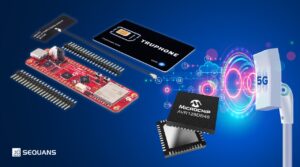IoT network developers are looking for an easy way to implement a secure cellular connection in their design applications, but face design complexities and high deployment costs.
 To provide a solution for network designers who need the ultimate in location flexibility, low power consumption and deployment simplicity, Microchip Technology announced the AVR-IoT Mini Cellular Development Board based on the AVR128DB48 8-bit microcontroller (MCU).
To provide a solution for network designers who need the ultimate in location flexibility, low power consumption and deployment simplicity, Microchip Technology announced the AVR-IoT Mini Cellular Development Board based on the AVR128DB48 8-bit microcontroller (MCU).
This solution provides a robust platform to start building sensor and actuator nodes in 5G narrowband IoT networks.
The AVR-IoT Mini Cellular Development Board is a small form factor board, making it an ideal solution for developers who want to connect IoT devices to an available 5G network. This is an essential feature for devices on the road or located in remote areas with limited availability of wide area networks (LoRa) or other low-power wide area network (LPWAN) solutions.
Customers can enjoy the flexibility and ease of design offered in the latest AVR128DB48 family of 8-bit MCUs, including security protection with Microchip's ATECC608 encryption device. The ATECC608 device can be easily configured for most major cloud service providers via Microchip's IoT provisioning tool.
“Microchip continues to expand its family of 8-bit AVR MCUs so developers can implement a variety of embedded designs with ease and flexibility,” said Greg Robinson, vice president of marketing for Microchip’s 8-bit MCU business unit. Microchip. “The ability to connect remote and mobile devices to a 5G narrowband network with an 8-bit MCU opens up new opportunities for battery-operated devices due to key factors such as low power consumption combined with high-quality analog peripherals.”
The AVR-IoT Mini Cellular Development Board comes pre-configured to send data from integrated light and temperature sensors to the cloud, viewable using Microchip's sandbox portal. The sandbox portal gives customers the ability to track and monitor their devices in real time from a remote location. This functionality covers the key requirements of many applications across various sectors, including agriculture, industry and energy, as well as consumer spaces such as freight transport, alarm systems, building automation and remote monitoring.
To provide an even easier, more efficient and cost-effective solution for developers to connect IoT devices to 5G using the AVR128DB48 MCU, Microchip has partnered with Sequans to include its Monarch 2 GM02S single-chip radio equipped with 5G LTE-M and IoT from narrow band. . Microchip has also partnered with Truphone to provide the cellular service SIM card that provides reliable coverage around the world.
“The Monarch 2 GM02S is a 5G-ready LTE-M and narrowband IoT solution on a single chip, which we designed specifically for narrowband IoT applications, including sensors, wearables and other low-data, low-power devices. energy,” said Didier Dutronc, executive vice president of partnership strategy at Sequans. “By partnering with Microchip on their AVR-IoT cellular board, we are simplifying and reducing the costs of IoT device design.”
“We are committed to reinventing the way people, things and businesses connect through our innovative embedded SIM (eSIM) technology,” said Steve Alder, director of business development at Truphone. “Owning and operating all elements of the eSIM ecosystem in-house, along with access to a large number of low-power cellular networks through a single SIM SKU, provides Microchip customers who want to connect IoT devices with seamless cellular service. of the future.”
The AVR-IoT Mini Cellular Development Board is a great solution for makers and hobbyists as it adapts to the Adafruit Feather form factor. Features a Qwiic/Stemma I 2 C Connector for easy functionality extension, creating a clear path to production. It is also Arduino® - compatible and is supported by Microchip's Github Library, which provides functionality for HTTPS, MQ Telemetry Transport (MQTT), low power consumption, and more.
Users can visit Microchip's sandbox page for a tutorial on the steps required to get up and running and establish a connection with the AVR-IoT Mini Cellular Development Board.

